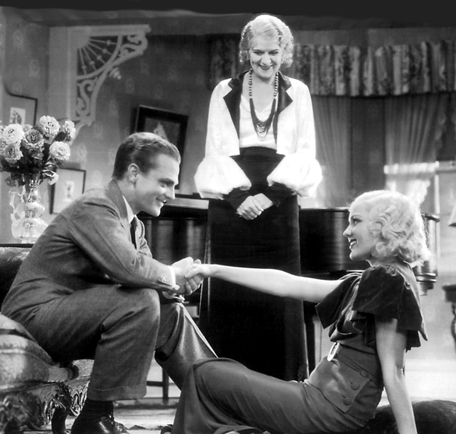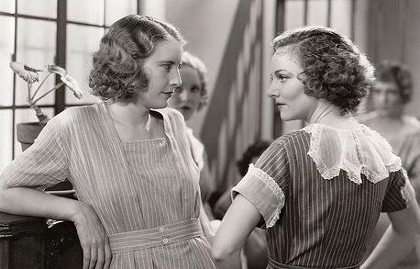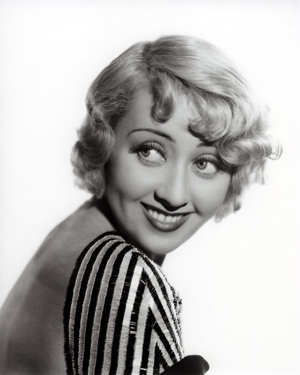
 |
|
|
|
Released concurrently with the amusing Forbidden Hollywood Volume 4 collection, the Warner Archives' Forbidden Hollywood Volume 5 Collection has a wider range of stars, subject matter and attitude. Although sex works its way into most of the stories, the accent this time is on comedy, circa 1933. Just four years previously, screen actors were more concerned with articulating their words rather than reading them in any particular way, but an influx of hot New York stage talent gave Warners' a special voice loaded with sass, character and theatrical finesse. Leading the ranks of smart-talking newcomers were James Cagney and Joan Blondell, each of whom gets a separate vehicle to billboard their unique personalities and snappy patter. Even for diehard fans of Pre-code cinema, these titles will be a refreshing discovery. 
1933's Hard to Handle begins the set with top star James Cagney in fine form as Lefty Merrill, a publicity agent running from one disaster to another. In sunny California, Lefty's marathon dance contest is big success until his partner ducks out with the prize money, leaving him holding the bag. In love with Ruth (Mary Brian), the contest winner, Lefty runs up against Ruth's chiseler of a mother, Lil (Ruth Donnelly), who skips to New York after selling a full apartment of furniture -- owned by her landlord. Following Ruth to New York, Lefty's gift for promotions find success until he runs afoul of a fraudulent promoter of grapefruit-growing land in Florida. The Grapefruit King's playgirl daughter Marlene (Claire Dodd) spoils Lefty's romance with Ruth. The only way our fast-talking hero can avoid a long prison sentence is to find a way to make grapefruit a cash crop again. James Cagney makes this preposterous story function by sheer star power and the energy of his personality. Lefty's joyfully mercenary (practical?) attitude toward the Depression is best expressed when he tries to talk his partner into an investment: "The public is a big cow begging to be milked, and you can't be bothered to get yourself a bucket!" No setback is permanent. A face cream is so badly formulated that it won't rub in, so Lefty promotes it as a way to lose weight: all that rubbing is good exercise. Just the same, Lefty keeps being undone by the greed of his clients. The owners of a funfair pier are too cheap to put more than $10 of prizes into Lefty's ingenious treasure hunt scheme. A mob of treasure hunters destroy the pier in a riot worthy of The Day of the Locust. Director Mervyn LeRoy keeps things bouncing merrily along as Lefty's situation rises and falls. The film opens with an impressive dance marathon scene almost as realistic as the one in They Shoot Horses, Don't They? Sterling Holloway is one of the suffering dancers, while emcee Allen Jenkins makes approving speeches and the bloodthirsty crowd waits to see if somebody drops dead on the dance floor. Even more satisfying is the running battle between Lefty and his sweetheart's scheming mother, who proclaims that there's no such thing as an honest person in Southern California. Depending on the state of his bank account, Ruth Donnelly is showing Lefty the door in one scene and kissing up to him in the next. Robert Lord and Wilson Mitzner's sharp script comes up with plenty of good material for Cagney to dig into -- he's as sassy as ever. And that whole grapefruit business has to be nod to Cagney's instantly famous scene in The Public Enemy. 
With 1933's Ladies They Talk About Warners hands us a full-on WIP (Women in Prison) picture, complete with the usual absurdities of man-hungry females penned up behind bars. New convict Barbara Stanwyck sees a very masculine-looking woman in the latrine. Her new friend Lillian Roth gives her some advice: "Watch out for her -- she likes to wrestle." The morally minded screenplay finds a lot of gray area in the story of a revivalist reforming a gangster's girl. Hardboiled moll Nan Taylor (Stanwyck, never saucier) gets caught helping her crook boyfriend Don (Lyle Talbot) knock over a bank. Her case attracts David Slade (Preston Foster), a radio preacher with honest political ambitions. Because he loves her, Slade is willing to risk everything to get Nan's case dismissed. Impressed, Nan puts him to the test by confessing that she really did assist in the robbery. To her surprise Slade backs down and she's convicted. After a few weeks in San Quentin Nan starts returning David's letters. He still wants to wait for her release, and she realizes that she loves him too. But there are complications. Deranged convict Susie (Dorothy Burgess) is so jealous of Slade that she'll do anything to keep Nan away from him. Worse, Don is now imprisoned in the men's wing of the Big House, and involves Nan involved in an escape through the women's wing. She's suddenly in trouble deeper than ever. Besides providing one of them more seductive posters of the 1930s Ladies They Talk About sees Barbara Stanwyck again coming up with an interesting performance as a morally compromised woman. Nan Taylor plays the tough girl when she has to but can also feel the pull of a decent relationship. The story has some unusual ideas about what's morally acceptable -- a popular preacher uses his clout to circumvent the law and spring Nan, and the only person who objects is Nan herself. Nan participates in a breakout that gets two men killed, and then only has a year or two added to her sentence. Come to think of it, this is one accommodating prison, where the cells are called rooms and everybody gets to keep fairly attractive street clothes with them. The prisoners can walk out for a stroll in an attractive exercise area any time they wish. The Warners casting office populates the cellblock with some pretty tough women, however. Madame Sul-Te-Wan played unhappy black servants for decades, and here is quite effective as a laundry worker given a hard time by an older ex- brothel madam. Etta Moten, who sings "Remember My Forgotten Man" with Joan Blondell in Gold Diggers of 1933, sings here as well. Some of the WIP situations are pure camp, as when Stanwyck and Dorothy Burgess square off for a catfight. Lillian Roth (the subject of the tell-all book and movie I'll Cry Tomorrow) certainly looks cute, and sings a song as well: "If I Could Be With You"... to a picture of Joe E. Brown. In this one Ruth Donnelly has a much smaller part as a friendly prison keeper. Preston Foster is consistent, if a little boring as the revivalist good guy. We accept his Dave Slade as a romantic target mostly because Stanwyck's character sells the idea so well. Ladies They Talk About moves adroitly from one melodramatic scene to the next. 
1933's The Mind Reader turns the spotlight on the capable, versatile actor Warren William, whose specialty was cynical schemers that prey on innocent women like Loretta Young or Maureen O'Sullivan. This time out he's a carnival conman in search of the perfect racket. After trying patent medicine, painless dentistry (hilarious) and flagpole sitting (how does one profit from that?), he changes his name to Chandra The Great and settles on a sham mind reading act with his ever-slippery cohort Frank (Allen Jenkins). Frank sends Chandra the questions from the audience, and Chandra fakes his way through the rest of the act with theatrical malarkey. Complications? Chandra falls in love with the beautiful Sylvia (Constance Cummings), a small town girl so green that she actually believes he can read minds. They're married before Sylvia finds out about the scam, and Chandra must fast-talk her by claiming that the fake act is to support his other, truly beneficial mental powers (?). The fallout of Chandra's meddling in people's lives is illustrated when one of his victims (Mayo Methot, excellent) kills herself in grief. To keep Sylvia, Chandra goes straight, trying to sell brushes door to door in New York, with no luck. Then Frank shows up with a crooked new idea to bilk 5th Avenue housewives by selling them "mental visions" of their husbands' infidelities. Chandra becomes wealthy, without telling Sylvia about his newfound racket. Then she shows up at his office at the same time as an irate husband with a loaded gun... With Roy Del Ruth directing The Mind Reader packs a lot of incident into its 70 minutes, building to a very satisfying finish. The movie has a wickedly ambivalent attitude toward Chandra's chicanery. The patsies that fall for his act are so stupid that they almost deserve to be fleeced. Allen Jenkins' amiable crook, always ready to pull off another cheap scam, is a delightfully untroubled character. Sylvia seems rather thickheaded as well, so that we secretly pull for Chandra even when his bedroom-snitching game in New York leads to an outbreak of broken homes. Do we really believe Chandra's ultimate change of heart? For a half-comedy about carnival rip-offs in the Depression The Mind Reader pretty well outlines the American attitude toward success: I'm just trying to make a living. I didn't throw the woman down the elevator shaft. She was obviously unbalanced... why blame me? The show has a great ending. Seeing a friend off to jail, Allen Jenkins' Frank waxes philosophical -- as philosophical as he can get: "Aw, It sure is tough to be going away just when beer is coming back!" 
The much more frivolous Miss Pinkerton (1932) looks like a half-improvised story adapted from a 'spooky murder in the old house' novel by Mary Roberts Rinehart, the author of The Bat. Niven Busch was one of the writers adapting it to the screen, and it would seem as if a lot of changes were made to tailor the show for its bouncy, sassy star Joan Blondell. Adventurous Nurse Adams (Blondell) is detached from the hospital and assigned to the scene of a murder. She takes care of elderly Juliet Mitchell (Elizabeth Patterson) but also helps police Inspector Patten (George Brent) sift through the clues of the apparent suicide of Juliet's son. The house teems with suspects: a hulking butler and a sinister maid exchange "knowing" looks with the even more sinister Dr. Stuart (C. Henry Gordon). While everyone awaits Juliet's deposition, the victim's girlfriend Paula Brent (Ruth Hall) is caught sneaking into the house, and a stenographer (Mary Doran) may be in on some kind of conspiracy as well. Initial suspicion falls onto another man when Inspector Patten decides that the suicide may have been faked. Nurse Adams and Patten immediately take a liking to each other: he gives her the nickname "Miss Pinkerton" because she's helping to solve the crime. But will she be the next victim? The appeal of Miss Pinkerton relies on the winning personality of Joan Blondell, as the story is a shapeless mass of red-herring mystery nonsense and extended scenes of people pursued by menacing shadows as they creep up and down dark staircases. Director Lloyd Bacon never gives us a sense of the layout of the house, so half the time we don't know where we are. It doesn't really matter as few scenes have a bearing on the solution to the mystery. With Blondell cracking jokes and screaming in the dark, it's all good fun. But when it's over we feel a tiny bit cheated -- we want to go back and review all the misleading material where innocent characters exhibit overtly 'guilty' behavior. Joan Blondell and the young George Brent generate some chemistry, especially in a scene where, after getting familiar, they think to ask the other if they're married as an afterthought. There isn't much in the way of salacious Pre-code content, except for people talking about the victim's illicit relationship with the girlfriend, who would come to visit him at night in the spooky house. But the movie does manage one choice Pre-code moment: at the hospital Blondell asks her fellow nurses what they do to stave off boredom. As if answering herself, she immediately pulls her dress off over her head. When in doubt, have the actress disrobe! 
The Warner Archive Collection DVD-R set of Forbidden Hollywood Volume 5 carries each title on its own disc, perhaps indicating that the grouping was formulated after the titles were prepared for individual release. It's a fine set for both content and quality. All of the shows are in very good shape, with strong audio tracks. The only time we're at a loss is a scene where James Cagney talks so fast that we really can't make out what he's saying -- and the Warners people in 1933 probably had the same opinion. It's the only instance in one of Cagney's early films that I can say I've seen Cagney miscalculate! All of the shows come with original trailers, made to the same formula of big text animation, still photos and scene snippets, some of them outtakes. When Stanwyck knocks down her fellow inmate, the scene cuts to an angle not used in the film itself. The Forbidden Hollywood Volume 5 makes for fun viewing, with four top stars of the Pre-code era.
On a scale of Excellent, Good, Fair, and Poor,
Forbidden Hollywood Volume 5 rates:
Reviews on the Savant main site have additional credits information and are often updated and annotated with reader input and graphics. Also, don't forget the 2011 Savant Wish List. T'was Ever Thus.
Review Staff | About DVD Talk | Newsletter Subscribe | Join DVD Talk Forum |
| ||||||||||||||||||